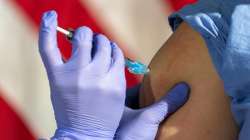Quarter of world may not have access to COVID-19 vaccine until 2022, study warns
Nearly a quarter of the world's population may not have access to a COVID-19 vaccine until at least 2022, according to a study published in The BMJ on Wednesday which warns that vaccines will be as challenging to deliver as they were to develop.

Nearly a quarter of the world's population may not have access to a COVID-19 vaccine until at least 2022, according to a study published in The BMJ on Wednesday which warns that vaccines will be as challenging to deliver as they were to develop.
Another study in the same journal estimates that 3.7 billion adults worldwide are willing to have a COVID-19 vaccine, highlighting the importance of designing fair and equitable strategies to ensure that supply can meet demand, especially in low and middle income countries.
These findings together suggest that the operational challenges of the global COVID-19 vaccination programme will be at least as difficult as the scientific challenges associated with their development.
ALSO READ | Development, distribution of COVID-19 vaccine Pfizer in such short time span a 'miracle': White House
In the first study, researchers from the Johns Hopkins Bloomberg School of Public Health in the US analysed pre-orders for COVID-19 vaccines ahead of their regulatory approval that had been publicly announced by countries around the world.
"This study provides an overview of how high income countries have secured future supplies of COVID-19 vaccines, but that access for the rest of the world is uncertain," the researchers said.
"Governments and manufacturers might provide much needed assurances for equitable allocation of COVID-19 vaccines through greater transparency and accountability over these arrangements," they said.
The researchers noted that by November 15, 2020, several countries had reserved a total of 7.48 billion doses, or 3.76 billion courses from 13 manufacturers, out of 48 COVID-19 vaccine candidates in clinical trials.
They said over half (51 per cent) of these doses will go to high income countries, which represent 14 per cent of the world's population, while low and middle income countries will potentially have the remainder, despite these comprising more than 85 per cent of the world's population.
If all of these vaccine candidates were successfully scaled, the total projected manufacturing capacity would be 5.96 billion courses by the end of 2021, with prices ranging from USD 6 per course to as high as USD 74 per course.
Up to 40 per cent of the vaccine courses from these manufacturers might potentially remain for low- and middle-income countries, the researchers said.
However, this will depend, in part, on how high-income countries share what they procure and whether the US and Russia participate in globally coordinated efforts, they said.
ALSO READ | Moderna COVID-19 vaccine 'highly protective', could receive emergency authorisation
The researchers noted that even if all of these vaccine manufacturers were to succeed in reaching their maximum production capacity, at least a fifth of the world's population would not have access to vaccines until 2022.
In the second study, researchers in China and the US estimated target populations for whom vaccines would be required, to help guide development of fair and equitable allocation strategies across the globe.
They found that target population sizes for COVID-19 vaccination vary widely by geographical region, vaccine objectives, such as maintaining essential core services, reducing severe COVID-19, and stopping virus transmission, and the impact of vaccine hesitancy in reducing demand.
The researchers point to evidence suggesting that around 68 per cent of the global population (3.7 billion adults) is willing to receive a COVID-19 vaccine, and say their findings "provide an evidence base for global, regional, and national vaccine prioritisation and allocation."
"Variations in the size of the target populations within and between regions emphasise the tenuous balance between vaccine demand and supply, especially in low and middle income countries without sufficient capacity to meet domestic demand for COVID-19 vaccine" they said.
Both studies are observational, and the researchers acknowledge the implications of uncertainty and incomplete information for their analyses.
The findings illustrate the considerable scale and complexity of manufacturing, purchasing, distributing, and administering COVID-19 vaccines in a way that meets global needs, and does so equitably among nations and populations, the researchers said.
Jason Schwartz at Yale School of Public Health noted in a linked editorial that many countries have already shown a commitment to equitable global access to COVID-19 vaccines by purchasing through the COVAX Facility -- an initiative that invests part of the payment in vaccines for poorer countries.
However, he said vigilance is required "to ensure that such aspirations are realised in the months and years ahead."